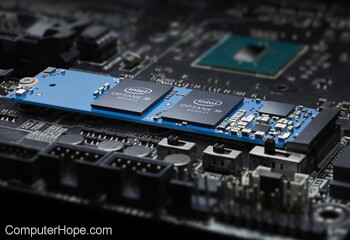Optane memory

Optane memory is a type of low-latency, persistent computer memory developed by Intel. It was released in March 2017.
In July 2022, Intel announced they were discontinuing their Optane product lines. In December 2023, the last of their Optane products were shipped to customers.
Benefits
Optane is not as fast as RAM (random-access memory), but has greater storage capacity for the equivalent cost. Unlike RAM, Optane memory is non-volatile (its data persists when its power source is disconnected).
Compared to traditional storage devices, such as a hard drive or SSD (solid-state drive), Optane offers smaller capacity, but at much faster speeds. Its operational latency (the delay when accessing data) is as low as 10 microseconds.
How and why Optane is used
Optane memory connects to the motherboard as an M.2 module.
Optane uses a technology called 3D XPoint, where memory cells are stacked in a multi-planar configuration. It is used primarily in servers, or in machine learning computing clusters, which benefit from high-speed access to massive data sets too large to store in conventional RAM.
Optane modules are available in capacities ranging from 16 GB to 512 GB.
Requirements
Using optane memory modules requires a motherboard that uses a 7th generation Intel Core i3, i5, or i7 processor (7xxx series).
Optane DC
In 2018, Intel also announced new Optane DC Persistent Memory, a type of memory that connects to a motherboard using a DRAM (dynamic random-access memory) slot. While similar to RAM in its motherboard connections and the memory module sizes, it differs from RAM in how it retains data. RAM temporarily stores data and loses the data when the computer is turned off, but Optane DC Persistent Memory retains data when the computer is powered down. However, it has a higher latency than RAM, so it's not yet a replacement for RAM.
Intel has designed the Optane DC Persistent Memory to be used with the next generation of their Xeon processors and compatible motherboards.
Optane SSD
Intel also offers "Optane SSD" modules, which combine 3D XPoint and NAND flash for a blend of speed, efficiency, and higher capacity.
Cache, DRAM, Hardware terms, Memory terms, Motherboard, Xeon
